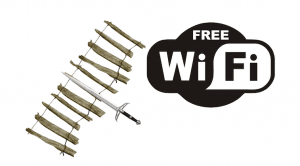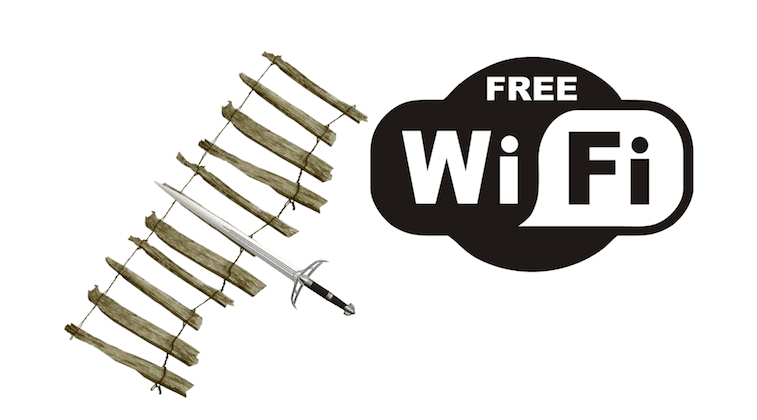I think you’d agree that access to the Internet has become second nature these days. When you check in at the hotel, receptionists know to indicate the wifi login even before telling where the gym or lifts are located or when breakfast is served. When a friend comes to stay with you, you will as readily send the wifi code along with instructions for entering the premises. In cities around the world, wifi is becoming available on the street, and is almost de rigueur at airports, in stores and cafés. In ‘normal’ offices, guests now typically have some specific log in options. So, we are all becoming increasingly familiar with, if not demanding about the wifi connection. Yet, some networks are much easier and friendlier than others to get onto. Whether because of technical limitations, security fears, cost or ignorance, some organizations see fit to make logging in something of a titanic struggle. And, I’m not even talking about the other problem of speed of connection.
Wifi – a harbinger of customer experience
I have no statistical evidence to base this on, but I have to believe there is a relationship between the wifi experience and the customer experience (CX) abilities of the company. My supposition is that the more convenient you make it for your customer, the more likely you have the right mindset to create a good customer experience. Share on X
Here are some ways that you can get access to wifi:
- Click on the open network (without need to log in). The device then auto-connects thereafter whenever the network is detected. (e.g. at a hotel out in the boondocks). NB Some open networks require a re-confirmation/opt in (despite using the same device).
- Select the network, then log in once (in the browser or popup) with varying degrees of personal data. The device then auto-connects thereafter. (e.g. password protected access at home). NB Some companies will use this to capture a client’s details. Will the subscriptions be opt in or opt out?
- Select the network and log in. Then you need to confirm the pre-saved log in every time you visit (eg. at Heathrow).
- Log in with limited long-term duration (e.g. for the duration of your hotel reservation).
- Log in with new credentials each day (e.g. some security conscious corporations). NB In this option, companies love to provide long strings of complicated and painful codes to type in on the small iPhone screen… 🙁
It’s not a definitive list and certainly, there will be many new ways invented in the future. But, the point is that as you go down the list, the difficulty of logging in increases. And, I would argue, the customer experience is diminished. To the extent you’re in an office, a retail environment or even at home, the way you craft the wifi access speaks to your empathic approach to others.
Wifi – a civic right?
More and more, cities are providing wifi access. For the more touristic towns, this is increasingly an obligation. Yet, cities can choose to do this in various ways, more or less friendly for visitors. Some cities choose to provide access available to all, as if it were a civic right. For others, it might be via a local telecom. And others still have not gotten with the program yet.
 In London, I’m always agreeably surprised how easily and well the ee/Virgin wifi works in over 100 Underground stations (for this to work, I note that you need to have an ee/Virgin contract). The device will connect automatically if the train stops long enough at the station. It’s a seamless experience. On several busy streets across London (eg Oxford Street, Kensington High Street…), equally, you can gain automatic access to the open and reasonably robust O2 wifi once you have logged in a first time. In Paris, meanwhile, with my Orange contract, I have permission to log in to the Orange network in the streets. However, if the coverage is quite good, the system is extremely laborious compared to the London options. In fact, it tends to aggravate me more than anything else. First, my device will automatically identify the Orange network, but it won’t log in because that is a multi-step process. In the meantime, your non-functioning wifi will block 4G access so you are without network. You need to go to your browser to log in or else your phone is blocked from connecting. Regularly, I am obliged just to turn off wifi to avoid the hassle. I certainly wish the folks at Orange would learn the better practices available elsewhere.
In London, I’m always agreeably surprised how easily and well the ee/Virgin wifi works in over 100 Underground stations (for this to work, I note that you need to have an ee/Virgin contract). The device will connect automatically if the train stops long enough at the station. It’s a seamless experience. On several busy streets across London (eg Oxford Street, Kensington High Street…), equally, you can gain automatic access to the open and reasonably robust O2 wifi once you have logged in a first time. In Paris, meanwhile, with my Orange contract, I have permission to log in to the Orange network in the streets. However, if the coverage is quite good, the system is extremely laborious compared to the London options. In fact, it tends to aggravate me more than anything else. First, my device will automatically identify the Orange network, but it won’t log in because that is a multi-step process. In the meantime, your non-functioning wifi will block 4G access so you are without network. You need to go to your browser to log in or else your phone is blocked from connecting. Regularly, I am obliged just to turn off wifi to avoid the hassle. I certainly wish the folks at Orange would learn the better practices available elsewhere.
Don’t leave CX to IT

How easy do you make getting on to your Wifi network?
Similarly, in cafés and offices, there is a wide array of experiences for employees and guests. You can quickly see those places whose IT department was left alone to configure the wifi. Between multiple steps, unconscionable and incomprehensible long strings of passwords (especially for the small mobile keyboard) and slow networks, some companies have taken hospitality seriously while others not at all. Whatever you do, don't leave your customer experience to the IT department. Share on X
I recognize that at times there are technical or cost issues, but today it’s no longer an anecdote as to the style and power of wifi access. And in many situations, access to wifi is an integral part of the customer experience.
My suggestion: Walk in the shoes of your guests/clients/citizens and see whether you, as the provider, find it an agreeable experience.












Trackbacks/Pingbacks